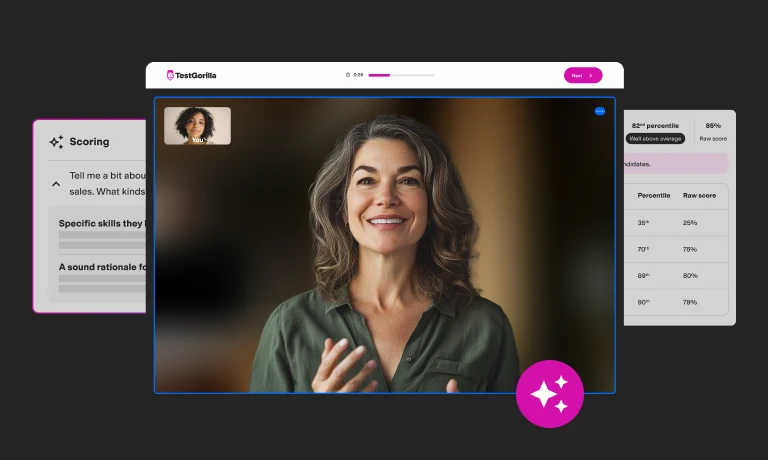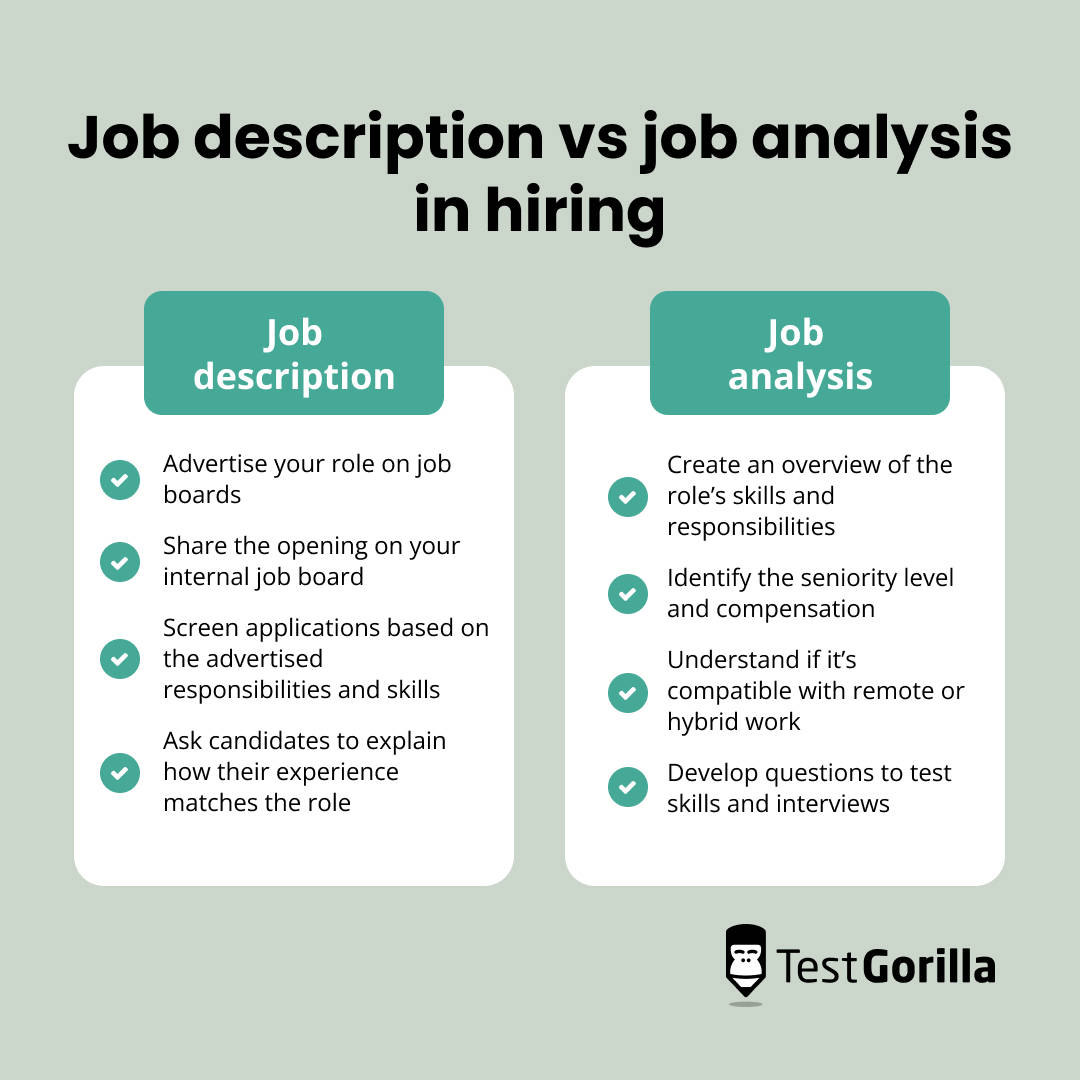The job analysis and job description are both important parts of the recruitment process, helping you find the right candidates for a role. However, they have different purposes, processes, and inclusions.
Using one when you should use the other could mean you’re not attracting or assessing your candidates effectively – which could lead to costly mis-hires.
Confused about the difference? We’re here to help. We cover this difference and more in our job analysis vs. job description comparison – so you can use both tools successfully.
What is a job analysis?
A job analysis is a process of gathering in-depth information about a given role. It offers your team a detailed understanding of the job’s tasks, responsibilities, work environment, and performance standards, as well as its required skills, knowledge, and training.
The results of a job analysis can be presented in a formal document, but they can also be recorded across multiple documents or discussed orally.
What is a job description?
A job description is a concise document summarizing a role’s top skills, responsibilities, and requirements. It also informs potential job applicants about the people they’ll report to, the compensation, and the company’s mission and culture. A good job description is tailored to each position so you attract the right candidates. For example, a strong home health care aide job description may address compensation and perks to encourage more qualified candidates to apply in a field affected by labor shortages.
The best insights on HR and recruitment, delivered to your inbox.
Biweekly updates. No spam. Unsubscribe any time.
Differences between job analysis and job description
While both the job description and job analysis contribute to hiring and evaluating employees effectively, they serve distinct purposes and contain different information.
Here are the top differences to be aware of.
The aim of a job analysis vs. job description
First, a job analysis and a job description have different aims.
The aim of a job description is to provide job seekers with a clear summary of the role’s key skills and responsibilities, thus encouraging suitable candidates to apply. Additionally, it helps recruiters and hiring managers screen applications.
A job analysis, by contrast, is often used internally and can serve multiple purposes before and after hiring, including:
Supplying information for a job description
Supporting employee performance evaluations
Determining appropriate compensation levels based on experience and/or performance
Helping ensure compliance with labor laws
Examining workforce training needs, including health and safety training
The steps required for a job analysis vs. job description
A job description and job analysis also differ in terms of process. For instance, a job analysis involves gathering and interpreting data. It might involve the following steps:
Collecting job data through questionnaires and interviews with key stakeholders, such as line managers, team members, and current job holders
Compiling a list of job tasks and skills, including detailed explanations and examples
Highlighting crucial details about the job, such as work relationships, travel requirements, training requirements, and legal considerations
Categorizing and interpreting the data – for example, rating tasks by importance and marking skills as desired or required
In comparison, drafting a job description involves identifying and summarizing key responsibilities and skills from your job analysis. You also add qualification requirements, compensation information, and a company intro. Finally, you structure and proofread your document so all applicants find it easy to read.
The content of a job analysis vs. job description
While a job description and job analysis may feature overlapping content, they involve different levels of detail. The job analysis contains in-depth information about every aspect of the role. It usually contains:
Responsibilities and tasks, including frequency and difficulty levels
Skill and qualification requirements, including proficiency levels
Work environment, including physical ability or health requirements, driving requirements, and unique social dynamics
Physical and technical tools, such as specialized machinery or software
Working relationships, including line managers, team members, and clients
Performance standards – for example, if the company expects performance above a specified measurable level
Legal considerations, such as whether the role has exempt or non-exempt status under the Fair Labor Standards Act
Job descriptions, however, are concise, including only details required to attract and assess applicants, including:
Company description, culture, and perks
Compensation details
The type of employment (full-time/part-time)
The department and reporting relationships
A job summary
Key responsibilities
Required skills and experience
Required years of experience in a similar role
Desired and required qualifications
Recommended reading: Words and phrases to avoid when writing a job description
How to use a job description and job analysis in hiring
Both the job description and the job analysis can help you attract suitable candidates and ensure you hire the best person for the job.
For instance, a job analysis helps you:
Create an overview of the role’s skills and responsibilities
Identify the seniority level and compensation that are suitable for the role
Understand if the job is compatible with remote or hybrid work
Develop questions to test key skills in talent assessments and interviews
Meanwhile, with a job description, you can:
Advertise your role on job boards
Share the opening on your internal job board to capture existing employee applications and referrals
Screen applications based on the advertised responsibilities and skills
Ask candidates to explain how their experience matches the role
Both the job analysis and the job description are highly valuable when assessing applicants. For example, skills featured in your job description can help you develop behavioral interview questions, like “Tell us about a time when you showed team leadership.”
Similarly, tasks from your job analysis can help create scenario-based questions for skills assessments.
Hire outstanding talent with TestGorilla
While a job description and job analysis may be similar, they have striking differences in aims and level of detail. Avoiding confusion between them enables you to use both tools effectively when attracting and assessing your applicants.
Once you’ve completed your job analysis and job description, the next step is identifying suitable candidates. A talent assessment platform like TestGorilla spotlights your top applicants using bias-free tests and one-way interviews. You can choose from 300+ tests and customize questions to suit your role. What’s more: you can combine up to five tests in a single assessment, ensuring you gain a comprehensive understanding of each candidate.
To learn more, take a quick product tour or sign up for our free plan.
You've scrolled this far
Why not try TestGorilla for free, and see what happens when you put skills first.



















